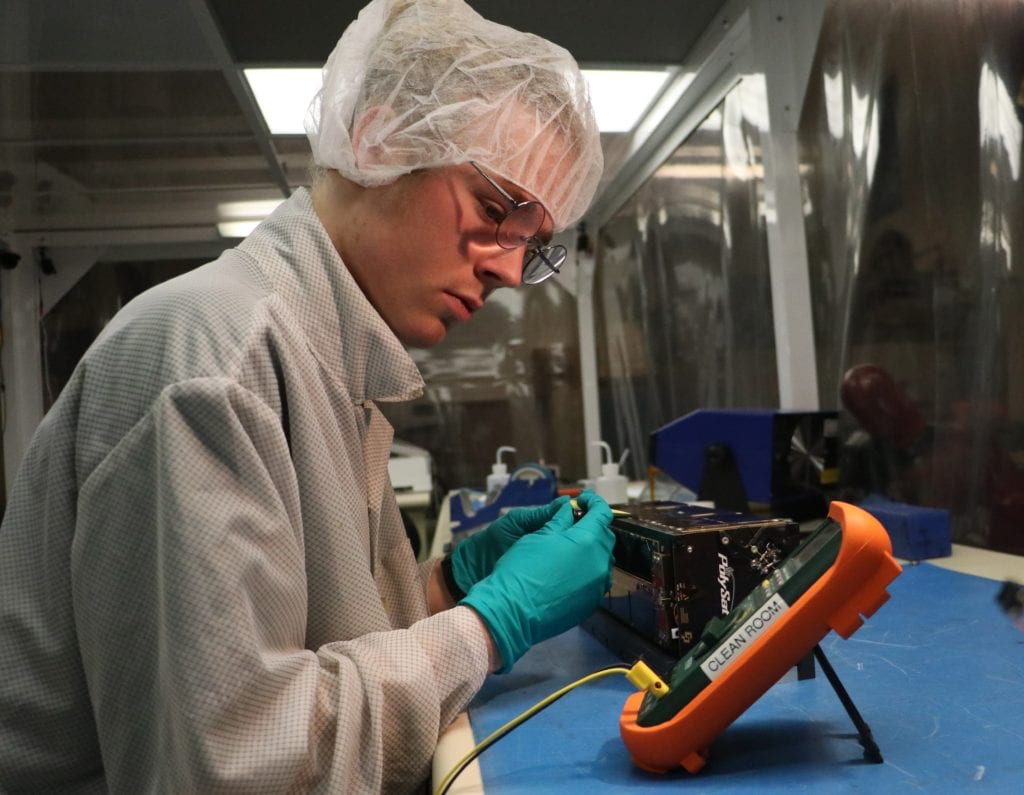A partnership with the Air Force Research Laboratory will direct roughly $2.5 million to Cal Poly to enhance its Aerospace Engineering Department and boost its mini-satellite program, which was the catalyst for a substantial expansion of space research two decades ago.
The Education Partnership Agreement (EPA) with the Air Force provides a total of $5 million for both Cal Poly campuses, split evenly between Cal Poly and California State Polytechnic University in Pomona. Funding for the partnership was secured by three U.S. representatives from California – Salud Carbajal, Norma J. Torres and Grace Napolitano — through the Consolidated Appropriations Act of 2020 (H.R. 1158).
EPAs, formal agreements between a defense laboratory and an educational institution, allow the labs to provide laboratory equipment and personnel to the schools, plus career and academic advice to students while involving faculty and students in research.
The EPA will help the Air Force Research Lab pioneer transformative aerospace technologies and accelerate its long-term strategic objectives in key areas such as energy security, energy optimization, reusability, maneuverability and multi-mission mobility.
“This partnership is an exciting opportunity to further the Learn by Doing ethos that has long given our students a competitive edge,” said Cal Poly President Jeffrey D. Armstrong. “With this mutually beneficial collaboration, our students and faculty will help the Air Force enhance its strategic capabilities in space operations through next-generation access to space and maneuverability.”
In particular, the funds for Cal Poly will support a thermal vacuum chamber, with upgraded facilities to support it. A thermal vacuum chamber can be used for testing spacecraft or spacecraft parts under a simulated space environment.
“Cal Poly is proud of its past contributions to aerospace technology, which have revolutionized space exploration,” said College of Engineering Dean Amy S. Fleischer. “We look forward to being an instrumental part of the next period of significant innovation – which this partnership will help us achieve.”
Cal Poly became a major contributor to space research roughly 20 years ago, when former Aerospace Engineering faculty member Jordi Puig-Suari co-created the CubeSat standard with Bob Twiggs of Stanford University. CubeSats are mini-satellites that are much more affordable and easy to make, allowing governments, schools and private companies worldwide to more easily and affordably explore space and conduct research.

The new vacuum chamber will allow researchers to test and develop propulsion for CubeSats – allowing for greater control of the satellites for space exploration. Currently, most CubeSats cannot be controlled in space, and propulsion and maneuverability is often viewed as the next major step in CubeSat technology.
“CubeSat technology has really progressed over the past 20 years,” said Robert Crockett, associate dean for innovation infrastructure at Cal Poly’s College of Engineering. “Helping to advance propulsion will help us maintain a leadership role.”
Cal Poly’s CubeSat program, Crockett added, is notable because it involves students in significant research, testing and development – and that Learn by Doing approach will be enhanced by working with the Air Force.
“We’ll be working very closely with the Air Force researchers,” he said. “With additional state-of-the-art technology, we’ll be able to do things that weren’t previously possible, which will prompt key players in the space industry to come to us often for both our facilities and our talent.”
The EPA is part of a larger partnership the two campuses have had with Edwards Air Force Base in Kern County, which will prepare students for the future.
“Military-educational partnerships enhance our national security capabilities and provide students with hands-on learning opportunities that set them up for successful STEM careers,” said Carbajal, whose Central Coast district includes Cal Poly. “I am so thankful to my colleagues, Rep. Torres and Rep. Napolitano, for their support, and I look forward to seeing the incredible developments the Cal Poly universities will make in the aerospace field through this partnership with the Air Force.”
Ten CubeSats developed at Cal Poly have been launched into space, and three more are currently in the works. Last summer, the Planetary Society used Cal Poly’s CubeSat lab as mission control for its launch of LightSail 2, a pioneering project that developed solar sails to help propel a mini-satellite.


